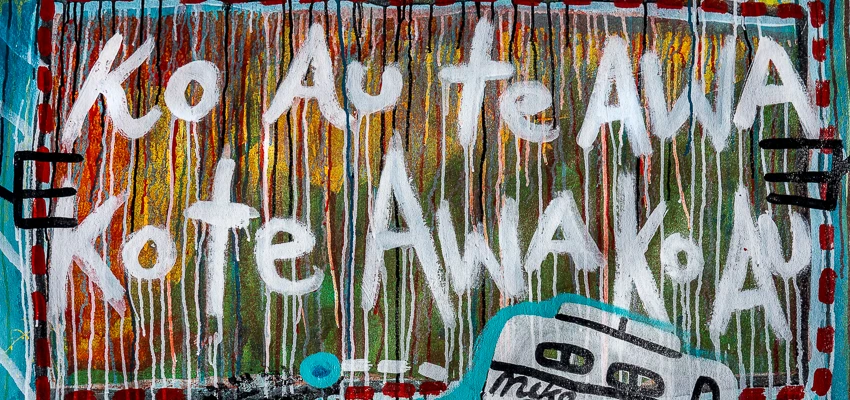Change-maker — the Whanganui River

'Ko au te Awa, ko te Awa ko au' nā Tāwera Tahuri, Ngāti Uenuku and Ati Hau Nui a Pāpārangi. All rights reserved.
Explore the fight for a river's rights. The Whanganui River is the first river in the world to be granted the same legal rights as a human being.
A long struggle
Ko au te awa, ko te awa ko au — I am the river and the river is me.
— Traditional saying of Whanganui iwi
The Whanganui River is the longest navigable river in Aotearoa. From Mount Tongariro to the Tasman Sea, the river has provided physical and spiritual support to Whanganui River iwi and their hapū.
In March 2017, the Whanganui River became the first river in the world to be given the same legal rights as a human being. This was the culmination of New Zealand’s longest standing legal battle.
Te Awa Tupua — Voices from the River (NZ On Screen video, 2:27) gives an introduction to the story of this river.
Background to the iwi's legal fight
The tribes of the Whanganui river take their name and draw their mauri (life force) and strength from a great river that flows from the volcanoes of the central North Island to the sea. For centuries, the people have travelled the Whanganui River by waka, caught tuna (eels) in it, built pā (villages) on its banks, and fought over it. The people say, "Ko au te awa. Ko te awa ko au" (I am the river. The river is me.)
—Whanganui tribes ('Te Ara')
Te Awa Tupua is a name that can't be translated into English. It is more than a place name. It includes the whole river system, its spirit, and the people that are related to it. The relationship between Te Awa Tupua and Whanganui iwi and hapū goes back hundreds of years.
Crown involvement with Whanganui iwi began in May 1840 when 14 rangatira signed Te Tiriti o Waitangi. 8 years later, the Crown purchased a large block of land at Whanganui and began to assert authority over the river.
Legislation allowed local authorities to build beside the river, but did not provide for Whanganui iwi involvement. Over the next 100 years, a steamer service was introduced, forest was cleared from river banks, gravel and sand extracted from the river bed, and water diverted into a power scheme. Whanganui iwi fought the changes and petitioned parliament because these activities damaged the health and well-being of the river.
Timeline of the changes to the river
Whanganui River claims
In 1988, the Whanganui River Maori Trust Board was established to negotiate the settlement of Whanganui iwi Treaty claims over the Whanganui River. In 1990, a claim was lodged with the Waitangi Tribunal on behalf of all Whanganui iwi.
The Whanganui River Claims Settlement Bill was passed on the 16th of March 2017. This provided for the full and final settlement of claims of Whanganui Iwi in relation to the Whanganui River.
Whanganui Iwi (Whanganui River) Deed of Settlement
A 'legal person' with a 'legal personality'
As part of this settlement, Te Awa Tupua became recognised as an:
... indivisible and living whole comprising the Whanganui River from the mountains to the sea, incorporating its tributaries and its physical and metaphysical elements ...
Te Awa Tupua will also be recognised as a legal person. Reflecting the view of the river as a living and integrated whole, Te Awa Tupua will have its own legal personality with all the corresponding rights, duties and liabilities of a legal person.
— Ruruku Whakatupua — Deed of Settlement
As a result, decisions that affect the Whanganui River must recognise the river’s legal status and its health and well-being. When the Bill was passed, Whanganui River became the first river in the world to be granted legal personhood status. The news was met with tears — it reflected over 160 years of fighting for recognition of the rights of the river and its iwi and hapū.
One outcome of the Whanganui River gaining human legal rights was a similar decision made 3 days later with the Ganges and Yamuna Rivers in India.
Read more about the Ganges and Yamuna decisions
However, this decision was later overturned by the Supreme Court in India.
India's Ganges and Yamuna rivers are 'not living entities'
Activity
Investigate the history of the Whanganui River.
Te Ara's article on Whanganui tribes is a useful starting point.
Discuss what the impacts might be on the river having the same legal rights as a human. Consider the potential impacts on:
the well-being of the river
the well-being of Whanganui iwi and hapū
the well-being of other rivers in the country
the environment (nationally and globally)
New Zealand’s reputation internationally.
Further reading
Jimi Jackson learns about the name of Whanganui (YouTube, 7:20)
Kaupapa on the Couch: Rivers are people too! (YouTube. 6:23)
Tutohu Whakatupua explained — 'Whanganui Chronicle'.
Whanganui river to gain legal personhood — Radio New Zealand.
New Zealand river granted same legal rights as human being — 'The Guardian'.
